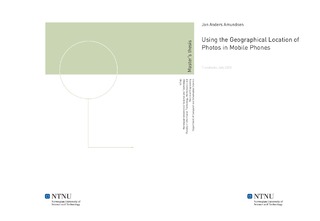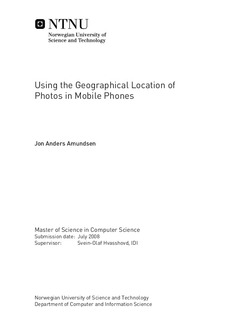| dc.contributor.advisor | Hvasshovd, Svein-Olaf | nb_NO |
| dc.contributor.author | Amundsen, Jon Anders | nb_NO |
| dc.date.accessioned | 2014-12-19T13:33:51Z | |
| dc.date.available | 2014-12-19T13:33:51Z | |
| dc.date.created | 2010-09-04 | nb_NO |
| dc.date.issued | 2008 | nb_NO |
| dc.identifier | 348706 | nb_NO |
| dc.identifier | ntnudaim:4277 | nb_NO |
| dc.identifier.uri | http://hdl.handle.net/11250/251301 | |
| dc.description.abstract | Digital cameras in mobile phones have become very popular in the recent years, and it is common to have large photo collections stored in the phone. Organizing these photos on the phone is still a big problem though. This study explores different ways of utilizing the location of where the photos were taken to make it easier to manage a large photo collection. Several different positioning technologies that can be used to obtain the location of where a photo was taken are presented. Three of the application suggestions for using location information of photos were implemented as prototypes on the Android platform. Android is a new platform for mobile phones developed by Google and the Open Handset Alliance, which has been made available as a preview release for developers. A part of this study was to investigate how suitable this platform is for developing location-based software. It was found that it is very suitable, although there still are some bugs and missing features that are expected to be fixed before the final release. The three application prototypes that were implemented were called “From Photo to Map”, “From Map to Photos” and “Who Lives Here?” The “From Photo to Map” application lets the user see a map where the location of a selected photo is visualized with a marker. The “From Map to Photos” application shows a map with markers at all of the locations where the user has taken photos. When one of the markers is selected, the photos taken at that location is shown. The “Who Lives Here?” application lets the user know which of the persons in his contact list that lives where the photo was taken. A small user survey showed that the participants thought all of the applications could be useful, but they were not so sure if they would use them themselves. The survey also showed that most of the users were able to find photos faster when using map-based browsing in the “From Map to Photos” application than when browsing through a photo collection linearly, but several concerns about the implementation details and the use of an emulator make the exact efficiency gain very uncertain. | nb_NO |
| dc.language | eng | nb_NO |
| dc.publisher | Institutt for datateknikk og informasjonsvitenskap | nb_NO |
| dc.subject | ntnudaim | no_NO |
| dc.subject | SIF2 datateknikk | no_NO |
| dc.subject | Data- og informasjonsforvaltning | no_NO |
| dc.title | Using the Geographical Location of Photos in Mobile Phones | nb_NO |
| dc.type | Master thesis | nb_NO |
| dc.source.pagenumber | 108 | nb_NO |
| dc.contributor.department | Norges teknisk-naturvitenskapelige universitet, Fakultet for informasjonsteknologi, matematikk og elektroteknikk, Institutt for datateknikk og informasjonsvitenskap | nb_NO |

